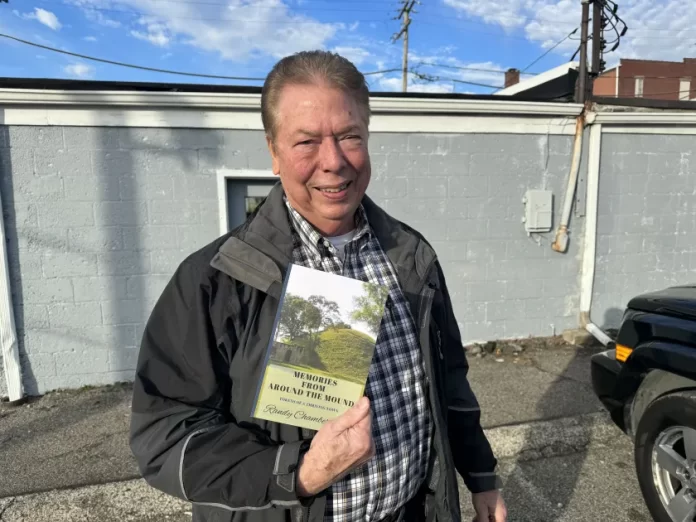
(Publisher’s Note:) This story by John W. Miller – owner of Moundsville.org – first appeared before Mr. Chamberlain’s book signing was scheduled for this Friday, so we decided to re-publish it to promote the 4-6 p.m. event. Refreshments will be served.)
During the 1950s and 1960s, when Randy Chamberlain was a boy in Moundsville, WV, people in the evenings “sat on their front porches talking with each other,” he told me. Chamberlain, 77, is a retired insurance rep, radio DJ and grocer, and city councilman who’s lived in Moundsville his whole life.
In 2018, Charlie Walton, the editor of The Moundsville Daily Echo, asked Chamberlain to write for the paper. Chamberlain, a born storyteller with a rich radio voice, produced Around the Mound, a charming weekly reflection on his beloved town and his life spent there.
Chamberlain wrote the column for three years, and gave it up when he picked up a seat on City Council. He didn’t want to compromise his journalistic integrity. But recently, he published a 150-page book called Memories From Around the Mound: Tokens of a Thriving Town (you can buy it here), a collection of his columns and some photographs.
The book’s been selling out all over town, and popping up with praise on Facebook, so yesterday I drove to Moundsville to ask Chamberlain why he thought it had been so successful. “People have really connected with it,” he told me over a cheeseburger at Bob’s Lunch. “People do tend to think that things were much better when they were young, but I also think we’re doing okay now.” Chamberlain is an optimist, and he’s right: Moundsville is doing better than most Ohio Valley towns.

In part, Memories From Around the Mound is a personal memoir and a narrative of shared American culture, especially musical. Chamberlain, a music maniac, chronicles his path into professional radio and America’s journey from Big Band to Rock and Roll, and tells charming stories about discovering Connie Francis, Bobby Vinton and Jerry Lewis.
There are also stories about important shared moments in America history and culture, such as watching the Marx Brothers, The Three Stooges, Superman, and quiz shows that turned out to be rigged, receiving the Sears-Roebuck catalogue ahead of Christmas, and experiencing news of the dropping the atomic bombs on Japan and the assassination of President Kennedy.
But the most touching parts of the book are Chamberlain’s descriptions of the community he experienced in Moundsville growing up in the 1950s and 1960s. Moundsville around Christmas reminded Chamberlain of the town of Bedford Falls in It’s a Wonderful Life. There were no shopping malls then, and people walked along Jefferson Ave, crisscrossed with artificial pine, Christmas wreaths and outdoor lights.
In the 1950s, Randy’s family didn’t own a car. “That meant we walked as a rule,” he writes. “In the winter when there was snow on the ground, our father would get out our sleds and pull us to grandma’s house. We were always excited to arrive at grandma’s. We knew there would be hot chocolate and fresh-baked raisin or chocolate chip cookies which grandma kept in an old marshmallow tin.”
Around that time, there were dozens of grocery stores in around and Moundsville. Chamberlain can still rattle off the names: Berry, Bonar, Cheslick, Gamble, Hill, Koontz, Simmons and Weaver. And those were among dozens of other local businesses: Rexall Drug, Jim’s Shoe Repair and Store, Remke Furniture and Appliance. (One of them, Ruttenberg’s, is still around and I’ve written about it here.)


